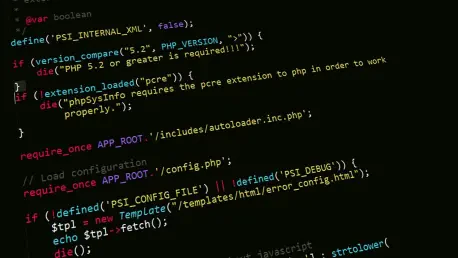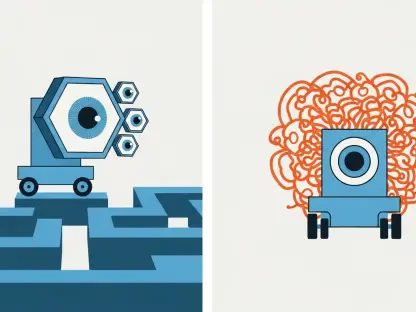Unlocking AI’s Inner Workings: A New Frontier in Debugging
The realm of artificial intelligence is grappling with a persistent challenge: ensuring that large language models (LLMs) reason reliably, especially in high-stakes environments like enterprise applications where a single error can lead to significant fallout. Recent advancements by researchers at Meta FAIR and the University of Edinburgh have introduced a pioneering debugging technique that promises to address this critical issue head-on. Known as Circuit-based Reasoning Verification (CRV), this method offers a deep dive into the internal mechanisms of LLMs, potentially revolutionizing how flaws in AI reasoning are identified and corrected.
This breakthrough arrives at a pivotal moment when trust in AI systems remains elusive due to inconsistent reasoning outputs, and the inability of current models to consistently align their generated responses with internal logic processes has hindered their adoption in sectors demanding precision and accountability. CRV emerges as a beacon of hope, aiming to enhance reliability by providing a structured way to monitor and rectify computational errors within these models.
By shedding light on the opaque inner workings of LLMs, CRV could mark the beginning of a new era in AI development, and this guide aims to explore the intricacies of this innovative technique. It offers a detailed look at how it functions and why it holds transformative potential. Readers will gain insights into a tool that might finally bridge the gap between AI capability and trustworthiness, paving the way for more robust applications.
The Challenge of Trustworthy AI: Why Reasoning Matters
Reliable reasoning stands as a cornerstone for AI systems, particularly in enterprise settings where decisions driven by LLMs can impact financial outcomes, operational efficiency, or even safety protocols. When these models falter in their logic, the consequences can range from minor inaccuracies to catastrophic misjudgments. Addressing this vulnerability is not merely a technical concern but a fundamental requirement for broader AI integration into critical industries.
Current LLMs often employ chain-of-thought (CoT) reasoning to tackle complex tasks, a method that has shown promise in enhancing performance. However, the generated CoT outputs frequently fail to mirror the internal reasoning processes, creating a disconnect that undermines confidence in the results. This discrepancy highlights a pressing need for tools that can scrutinize and validate the underlying logic, ensuring that outputs are both accurate and explainable.
Traditional approaches to error detection, such as black-box and gray-box methods, fall short in providing deep insights into system failures. Black-box techniques focus on surface-level outputs like final tokens or confidence scores, while gray-box methods probe raw neural activations for correlations with errors. Neither approach, however, uncovers the root causes of reasoning failures, leaving developers without actionable insights. This gap underscores the necessity for a more penetrating solution like CRV, which aims to dissect and diagnose the computational flaws at their source.
Inside the CRV Technique: A Step-by-Step Breakdown
Understanding and implementing Circuit-based Reasoning Verification (CRV) offers a structured path to diagnosing and correcting reasoning errors in LLMs, providing an unprecedented glimpse into the internal “circuits” of these models. This technique reveals the flow of computations that drive their outputs, making the process more accessible for analysis. By following a series of meticulous steps, CRV transforms the opaque nature of AI reasoning into a transparent, manageable process.
The methodology behind CRV is rooted in the concept that large language models (LLMs) operate through specialized subgraphs or circuits of neurons, functioning as latent algorithms. When reasoning fails, it often stems from flaws in these algorithmic executions, and the following steps outline how CRV systematically addresses these issues, equipping developers with a powerful tool to enhance model reliability.
This guide breaks down the CRV process into actionable stages, each designed to build on the previous one for a comprehensive approach to error detection and correction. From modifying model architecture to real-time interventions, every phase plays a crucial role in ensuring that AI reasoning aligns with intended outcomes. Readers will find detailed explanations to navigate this innovative debugging landscape.
Step 1: Transforming Models for Interpretability
The initial step in the CRV process involves reconfiguring LLMs to make their internal computations accessible and understandable, a critical move toward transparency in artificial intelligence systems. Researchers achieve this by replacing the standard dense layers within transformer blocks with specialized components known as transcoders. These components convert dense, indecipherable vectors into sparse, meaningful features, providing a clear view of the model’s intermediate calculations.
This transformation is essential for laying the groundwork for deeper analysis and understanding of complex models. Unlike traditional dense layers that obscure the reasoning process, transcoders act as a diagnostic interface, allowing for a detailed examination of how data is processed within the model. This step ensures that subsequent debugging efforts are based on interpretable data rather than guesswork.
By prioritizing interpretability, this modification sets the stage for precise error identification and ensures clarity in understanding complex processes. The use of transcoders ensures that the model retains its functionality while becoming more transparent, a balance that is critical for effective debugging. This foundational change enables a level of insight previously unattainable with standard LLM architectures.
Understanding Transcoders: A Window into AI
Transcoders differ significantly from other interpretability tools like sparse autoencoders, primarily in their ability to maintain the model’s performance while enhancing visibility. They are engineered to emulate the original dense layers without compromising the network’s operational integrity. This dual capability makes them indispensable for CRV’s diagnostic objectives.
Their role extends beyond the mere translation of data; transcoders provide a structured lens through which the complex computations of LLMs can be observed and analyzed. This clarity is vital for identifying specific points of failure within the reasoning process, making their integration into the model architecture a significant advancement in mechanistic interpretability.
Ultimately, transcoders serve as the entry point for debugging by ensuring that internal processes are no longer hidden in a black box. Their implementation allows researchers to pinpoint anomalies with precision, fostering a deeper understanding of AI behavior. This visibility is a cornerstone of the CRV methodology, enabling all subsequent steps.
Step 2: Building the Attribution Graph
Once the model is made interpretable, the next phase of CRV involves constructing an attribution graph for each reasoning step. This graph maps the causal flow of information between the interpretable features provided by transcoders and the tokens being processed by the model, serving as a detailed blueprint of how computations unfold within the system.
The attribution graph is a critical tool for visualizing the dependencies and interactions that shape the model’s outputs. By delineating the pathways through which data travels, it highlights potential bottlenecks or errors in the reasoning chain, making it easier to identify issues. This structured representation is essential for tracing the origins of computational discrepancies.
Creating this graph allows for a granular analysis of the model’s decision-making process at each stage, providing a comprehensive overview of how individual features influence the final result. It offers insights into the integrity of the reasoning steps and forms the backbone of CRV’s diagnostic capabilities, enabling precise error localization.
Mapping Causal Flow: The Power of Graphs
Attribution graphs function similarly to execution traces in traditional software debugging, offering a familiar framework for understanding complex processes. They reveal the sequence of operations and interactions that lead to a specific output, making it easier to identify where reasoning deviates from the correct path. This analogy aids in bridging the gap between conventional programming and AI analysis.
The power of these graphs lies in their ability to expose the causal structure of computations, providing a clear picture of cause and effect within the model. This transparency is invaluable for developers seeking to understand the intricacies of LLM behavior. It transforms abstract errors into tangible, traceable issues that can be addressed systematically.
By leveraging attribution graphs, CRV empowers users to dissect the computational flow with unprecedented detail, offering a powerful tool for understanding complex processes. This capability not only aids in error detection but also enhances overall comprehension of how LLMs process information. The graphs stand as a testament to the method’s potential to revolutionize AI debugging practices.
Step 3: Extracting Structural Fingerprints
Following the creation of the attribution graph, CRV focuses on extracting a structural fingerprint that encapsulates the key properties of the computational process. This fingerprint distills the complex interactions and dependencies within the graph into a concise set of features, and it serves as a unique identifier for the reasoning step being analyzed.
These structural fingerprints are instrumental in providing a snapshot of the model’s computational integrity, condensing vast amounts of data into actionable insights. They enable a focused assessment of whether the reasoning aligns with expected standards, making this extraction process a pivotal element of CRV’s error detection framework.
The significance of this step lies in its ability to simplify the vast complexity of AI computations into manageable indicators, making it easier to handle intricate data. By capturing the essence of the attribution graph, structural fingerprints facilitate a quicker and more efficient evaluation of reasoning correctness. They lay the groundwork for the diagnostic phase that follows.
Decoding Fingerprints: Signatures of Reasoning
Structural fingerprints act as signatures that distinguish between valid and flawed reasoning processes within LLMs, providing a way to analyze the integrity of computational logic. Each fingerprint carries unique markers that reflect the health of the computational trace, allowing for a nuanced understanding of where errors might reside. This decoding process is central to identifying problematic patterns.
By analyzing these signatures, developers gain critical insights into the specific nature of reasoning failures, and the fingerprints highlight deviations from optimal computational paths, offering clues about underlying issues that need correction. Their role in error differentiation cannot be overstated, as they guide subsequent diagnostic efforts.
These signatures elevate CRV’s approach beyond mere detection, providing a deeper layer of analysis that informs targeted interventions. Understanding the distinct characteristics of each fingerprint equips users with the knowledge to address specific flaws effectively, thereby enhancing the precision and reliability of the overall debugging process.
Step 4: Training the Diagnostic Classifier
With structural fingerprints in hand, the next phase of CRV involves training a diagnostic classifier to predict the correctness of each reasoning step. This classifier is developed using the extracted fingerprints as input data, learning to recognize patterns associated with accurate and erroneous computations. Its purpose is to serve as a vigilant monitor during model operation.
The training process focuses on equipping the classifier with the ability to distinguish between healthy and flawed reasoning traces, ensuring it can effectively identify logical patterns. By analyzing a diverse set of fingerprints across various tasks, it builds a robust understanding of what constitutes correct logic. This preparation ensures that the classifier can provide reliable assessments in real-world scenarios.
Once trained, the classifier becomes an integral part of the CRV framework, continuously evaluating model activations during inference. Its predictive capabilities allow for the immediate identification of potential issues, ensuring the integrity of the reasoning process is maintained. This step marks a significant advancement in automating error detection within LLMs.
Real-Time Feedback: Keeping AI on Track
The diagnostic classifier’s ability to deliver real-time feedback is a game-changer for maintaining AI reasoning accuracy, especially since it ensures that potential issues are caught and addressed promptly. As the model processes data, the classifier monitors its activations, instantly flagging any deviations from correct reasoning paths. This immediacy is crucial for preventing errors from propagating through the system.
Such feedback mechanisms ensure that issues are caught and addressed before they impact final outputs, significantly reducing the likelihood of errors in critical processes. This proactive approach minimizes the risk of incorrect conclusions or decisions, enhancing the model’s reliability in dynamic environments. The classifier’s role in providing ongoing oversight is indispensable for operational consistency.
By integrating real-time feedback, CRV offers a practical solution for sustaining AI performance under varying conditions, allowing developers to trust that the system remains on course even during complex tasks. This capability represents a significant stride toward creating dependable and responsive AI systems.
Step 5: Intervening to Correct Errors
The final step in the CRV process involves using the insights gained from error detection to implement targeted interventions. Once the diagnostic classifier identifies a reasoning flaw, CRV traces the failure back to specific components within the model, allowing for pinpoint accuracy that enables precise corrections, such as suppressing erroneous features to rectify mistakes.
Interventions are designed to address the root causes of errors rather than merely masking symptoms, ensuring a deeper resolution to underlying issues. By focusing on the exact points of failure, CRV ensures that corrections are both effective and sustainable. This step transforms diagnostic insights into actionable improvements, enhancing the model’s overall reasoning capacity.
The ability to intervene dynamically sets CRV apart from other debugging methods, offering a direct path to error resolution. Whether adjusting feature activations or recalibrating computational pathways, these corrections ensure that the model regains its intended functionality. This final phase completes the comprehensive approach to AI reasoning repair.
Precision Fixes: Correcting AI on the Fly
A notable example of CRV’s intervention capability is seen in a case study involving an order-of-operations error within a model. The system flagged a premature activation of a multiplication feature, which was leading to incorrect results. By suppressing this specific feature, the model corrected its reasoning path and successfully resolved the problem.
This precision in error correction highlights the practical impact of CRV’s methodology. Such targeted fixes demonstrate how quickly and effectively flaws can be addressed without overhauling the entire system. The ability to make on-the-fly adjustments is a testament to the technique’s adaptability and efficiency.
These interventions not only resolve immediate issues but also contribute to long-term model improvement. By learning from each correction, developers can refine the system to prevent similar errors in future operations. This dynamic approach to debugging underscores CRV’s potential to transform AI reliability and highlights the importance of continuous improvement in artificial intelligence systems to ensure consistent performance over time.
Key Takeaways from CRV’s Breakthrough
The achievements of Circuit-based Reasoning Verification (CRV) mark a significant milestone in AI debugging, offering distinct advantages over existing methods, and this breakthrough paves the way for more reliable and efficient systems in the field of artificial intelligence. The following points summarize its core contributions for quick reference:
- CRV outperforms black-box and gray-box approaches by providing a deeper, structural analysis of LLM computations, achieving higher accuracy in error detection across diverse datasets.
- It identifies domain-specific error patterns, revealing that different reasoning tasks exhibit unique computational signatures, which aids in tailored diagnostic strategies.
- The technique enables causal error tracing, allowing failures to be linked to specific components, and supports targeted interventions for effective correction, enhancing model reliability.
The Future of AI Debugging: Broader Implications and Challenges
The success of CRV opens up exciting possibilities for the future of AI development, potentially ushering in a new class of debuggers built on attribution graphs. Such tools could redefine how developers approach model failures, offering detailed execution traces similar to those in traditional software. This advancement promises a shift toward greater transparency and control over complex AI systems.
Beyond debugging, CRV’s framework could facilitate precise model fine-tuning and real-time error correction, making LLMs and autonomous agents more robust in unpredictable real-world scenarios. Applications might extend to optimizing training data or mitigating interference between competing tasks, reducing the need for extensive retraining. These prospects highlight the technique’s potential to streamline AI development processes significantly.
Nevertheless, challenges remain in scaling CRV to diverse contexts. The need for task-specific diagnostic classifiers means that adapting the method to new domains requires additional training efforts. Additionally, the complexity of implementing CRV across varied real-world applications poses logistical hurdles. Addressing these obstacles will be crucial for realizing the full potential of this innovative approach.
Moving Forward: Embracing AI Interpretability
Reflecting on the journey through Circuit-based Reasoning Verification (CRV), it became evident that this method stood as a pioneering proof-of-concept for mechanistic AI analysis. Each step, from transforming models with transcoders to executing precision interventions, contributed to a deeper understanding of how to mend flawed reasoning in large language models. The process illuminated a path toward building systems that users could trust in critical applications.
Looking ahead, the focus has shifted to actionable next steps for developers and researchers who are eager to build on this foundation. Exploring the publicly released datasets and transcoders offered by the Meta team presents an opportunity to test and refine CRV in diverse scenarios, allowing for innovation and improvement. Engaging with these resources could uncover new ways to enhance model reliability and address specific industry needs.
The broader adoption of interpretability tools like CRV promises to reshape the landscape of AI development. By prioritizing transparency, the field moves closer to creating systems that not only perform tasks but do so with verifiable accuracy. This commitment to understanding and improving AI reasoning lays the groundwork for future innovations that balance power with accountability.









